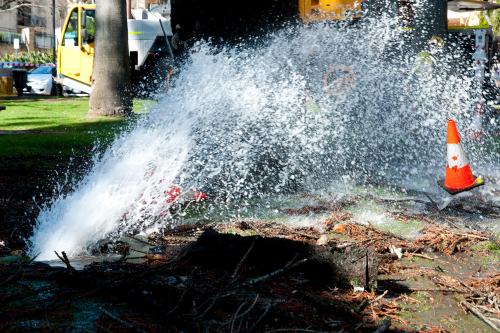Flint’s water infrastructure has reached a crisis point, as residents cope with high levels of lead pollution and questions mount over contamination and negligent oversight. Aiming to cut costs in a state of financial emergency almost two years ago, the city began drawing water from the local Flint River rather than continuing to depend on traditional sources linked to Detroit, almost immediately leading to a variety of health and environmental concerns. Although Flint switched back to Detroit water this past fall, the city’s situation remains dire.
A combination of factors, of course, have contributed to Flint’s crisis—including lapses in state monitoring—but the aging and deteriorating condition of the city’s water infrastructure plays an enormous role.
Similar to many older industrial cities in the Midwest, Flint has struggled to pay for needed maintenance on pipes and other facilities, which not only buckle under time and pressure in the form of widespread leaks, but also result in higher costs and declining water quality. Typically out of sight and out of mind, many pipes are more than a century old and are expected to need $1 trillion in repairs nationally over the next 25 years alone. With more than 51,000 community water systems scattered across the country and the federal government responsible for under one-quarter of all public spending on water infrastructure, states and localities must coordinate and cover most of these costs.
As a result, Flint is now facing a total water bill of up to $1.5 billion and needs a host of different public, private, and civic leaders to act to accelerate infrastructure improvements. Fortunately, several states and cities are pioneering innovative investments nationwide and providing models for future action.
Pennsylvania has driven funding in an assortment of drinking water, wastewater, and stormwater enhancements through its PENNVEST effort, providing nearly $8 billion in grants and low-interest loans to eligible projects since its inception in 1988. Likewise, with an emphasis on long-lasting environmental and economic benefits, Massachusetts has looked to target investments in aging facilities, provide clearer technical assistance, and encourage greater regulatory efficiencies. Other initiatives recently announced in New York have also helped tilt additional state support behind cleaner, more sustainable water improvements.
Many cities have pursued innovative planning and investment strategies as well. For example, Columbus created an integrated “blueprint” plan to specifically address its sewer and stormwater needs, looking to invest more extensively in green infrastructure. Chicago has touted an ambitious plan to pump more than $1.4 billion into water upgrades over the next decade, aiming to draw support from various public and private sources. Active efforts are also underway in Baltimore, which is replacing and relining aging pipes and carrying out other treatment plant upgrades to curb future service disruptions.
As Flint emerges from its current water crisis, it offers a cautionary tale to several other aging cities nationally. While extreme and unique in some ways, Flint’s predicament reveals broader infrastructure concerns that demand attention.











Commentary
Flint’s water crisis highlights need for infrastructure investment and innovation
January 13, 2016